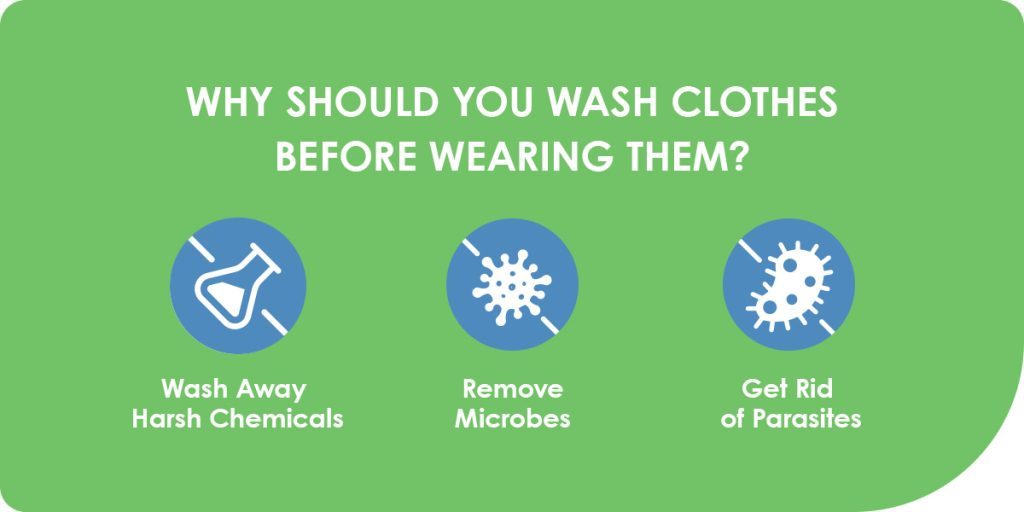


New clothes may look sparkling clean, but expert testing tells us a different story under the microscope. Whether you buy your clothes from online stores, secondhand shops or physical retailers, you’re at risk of coming into contact with contamination. Learn when and how to wash your latest outfits, why it’s so important to wash new clothes, what can happen if you don’t and how to keep garments looking fresh for years to come.
You might wonder, ‘Should I wash new clothes before wearing them?’ The answer is a resounding yes. You should wash every new article of clothing you buy to protect yourself and your family, whether your new garments come from a brick-and-mortar retailer straight off the rack, an online clothes outlet or a secondhand shop. Although they may look crisp and fresh, microbes or strong chemicals are often on newly bought garments and clothing donated to charity shops and thrift stores. By thoroughly washing your new clothes, you can greatly reduce exposure to chemicals, bacteria, fungi and parasites.
When shoppers try on potential new outfits, the fabric can pick up contaminants from their skin, hair or other clothes, even if they are only worn for a short time. These contaminants can survive for a long time and accumulate as more people try them on. New clothes often also harbor chemical traces from their time in the factory, including dyes, anti-mildew agents, softeners and anti-wrinkle treatments. These chemicals can lead to allergic reactions and illness if not washed away.
Online stores pose the same risks as walk-in clothing retailers. The garments are exposed to the same hazardous chemicals during manufacturing and can sometimes harbor even more. One study on clothes safety found clothing articles from low-cost, fast-fashion outlets contained concerning concentrations of phthalates, lead and other chemicals. Hazardous chemicals were found on children’s and even babies’ clothes in concentrations deemed unsafe by North American governments.
Ordering outfits online also doesn’t eliminate the risk of contamination from shoppers trying on clothes. Most online clothing retailers have return policies allowing customers to return garments after trying them on. This exposes the fabric to microbes, fungi and flora from the initial purchaser’s home. Shoppers who order online may receive these returned clothes sold as new, and they can pick up contaminants from the previous wearer if they don’t first wash them.
There is no guarantee that donors wash their secondhand clothes before they hand them in to be sold. Research has shown high numbers of parasites and ectoparasites in unwashed secondhand clothes, while no parasitic contamination was found on washed secondhand clothes. Even if donors did give their clothes a good wash before donating them, they could have used low-quality detergents or softeners with irritating ingredients and fragrances that lead to contact dermatitis or eczema.
Brand-new clothes given to charity shops arguably pose the greatest risk — they could harbor chemicals from the manufacturing process and microbes from being tried on before donation, and they have also been in contact with other, older, unwashed secondhand clothes.

Washing your newly bought garments helps protect yourself, your family, your visitors and your pets from becoming ill. There are three major reasons to vigorously wash any new clothes before wearing them or putting them away — microbes, parasites and hazardous chemicals. By washing your new clothing, you can:
Most skin irritation or contact dermatitis people experience from wearing clothes comes from allergic reactions to chemicals in clothing dyes. New, unwashed garments may contain higher levels of these allergenic dyes, and if people wear them before washing, the dyes can seep out of the clothes and irritate the skin.
Dyes are not the only chemical that can cause a reaction. Clothes are often treated with anti-microbial chemicals to prevent them from growing mold and mildew during their long journey from manufacturer to retailer. These chemicals, alongside treatments to enhance texture and fire resistance, can release carcinogenic formaldehyde when cured, causing a range of symptoms from skin irritation to breathing problems. The United States has no restrictions on how much formaldehyde can be in clothing fabric, unlike Finland and Japan, although Minnesota has banned the chemical in children’s products as of 2016.
Microbes such as fungi and bacteria can cause disease in humans, and new clothes can harbor all kinds of microbes. Contaminated garments can be straight off the rack of both high- and low-end clothing retailers. In addition to fungi and bacteria, clothing can also have yeast, traces of mucous and even excrement.
New clothes tried on by afflicted people or garments that have had contact with contaminated articles can carry parasites, both microscopic and visible to the naked eye. Scabies is a skin disease caused by the parasite Sarcoptes scabiei, which is only visible under the microscope and can hitch a ride on new clothes, infecting the wearer. Other parasites have also been found on both secondhand and brand-new clothes. Fortunately, giving clothes a pre-wear wash on the hottest setting of your washing machine kills and flushes away pathogens, something especially important should you wash new underwear or swimsuits.
If you wash your new clothes with high-quality detergent in clean, preferably hot water, for a long cycle, you can significantly decrease your exposure to chemical and biological contaminants. However, one wash may not be enough to rid the fabric of all chemicals fully. A second wash without detergent can help remove lingering toxins, but some fabric treatments may continue to irritate the skin even after washing.
Per- and polyfluorinated substances (PFAS) are chemicals used to make clothes waterproof and are often called “forever chemicals” because the body can’t eliminate them. According to the CDC, these PFAs pose a potential threat to endocrine and immune systems and other key bodily processes. Washing new clothes made with PFAs may remove some toxic chemicals from the garments themselves, but they stay around in the environment because they don’t break down. It’s safest to purchase high-quality clothing made from non-synthetic materials.
Your new clothes can still look as crisp and white as they did on the rack, even if you wash them. When washing clothes in cold water, you can save energy and help preserve the color and fabric of your garments. To ensure the latest additions to your wardrobe stay looking their best, you can apply these simple tricks:

Learn more expert laundry tips to keep your clothes in top condition. If you manage a commercial laundry room, reach out today to upgrade your equipment with Caldwell & Gregory. We provide leading laundry technology, excellent customer service and around-the-clock support to hotels, apartment buildings, gyms, resorts, universities and colleges. You can contact us today and enter the new generation of communal laundry services. Read our laundry tips & tricks blog for additional guidance on keeping your clothes in pristine condition.
Tips for Saving Money While Doing Laundry